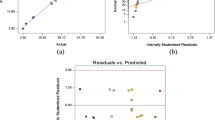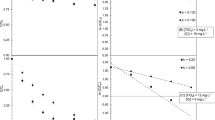Abstract
In our study, the effectiveness of photocatalytic degradation of methyl orange (MO) in the presence of several catalysts under simulated solar light was studied. A comparative study was conducted between four different catalysts (TiO2, Cu2O, WO3, and Bi2O3) to assess their photocatalytic activities by varying the illumination time. The photodegradation was examined through quantification of the photogenerated reactive oxygen species (ROS). In situ photogenerated hydroxyl radicals (⦁OH) were detected with terephthalic acid (TA) dosimetry based on fluorescence spectroscopy. Therefore, the concentration of ⦁OH was expressed according to the relative fluorescence intensity. Moreover, proof of a nonlinear relationship connecting the kinetics of the photocatalytic degradation of MO and the generation of ⦁OH radicals was demonstrated using coefficients of determination (R2). This brought new insights regarding the mechanism of the photocatalytic activity. Our findings indicate that the generated ⦁OH radicals from heterogeneous photocatalytic systems are not the unique factor involved in organic pollutant elimination; the double metal structure of metal oxides should also be taken into consideration.









Similar content being viewed by others
References
Abou Saoud W, Assadi AA, Guiza M, Bouzaza A, Aboussaoud W, Ouederni A, Rtimi S (2017) Study of synergetic effect, catalytic poisoning and regeneration using dielectric barrier discharge and photocatalysis in a continuous reactor: abatement of pollutants in air mixture system. Appl Catal B 213:53–61
Assadi AA, Palau J, Bouzaza A, Wolbert D (2013) Modeling of a continuous photocatalytic reactor for isovaleraldehyde oxidation: effect of different operating parameters and chemical degradation pathway. Chem Eng Res Des 91(7):1307–1316
Assadi I, Assadi AA, Elfalleh W, Bouzaza A, Ferchichi A, Wolbert D (2017) Combined system of natural pomegranate as heterogeneous bioadsorbent and photocatalysis for removal of textile dye herbicide in presence of heavy metals: effect of operating parameters and reaction monitoring. Desalin Water Treat 67:339–345
Ayed L, Ksibi IE, Charef A, Mzoughi RE (2021) Hybrid coagulation-flocculation and anaerobic-aerobic biological treatment for industrial textile wastewater: pilot case study. J Text Inst 112(2):200–206
Azzaz AA, Jellali S, Assadi AA, Bousselmi L (2016) Chemical treatment of orange tree sawdust for a cationic dye enhancement removal from aqueous solutions: kinetic, equilibrium and thermodynamic studies. Desalin Water Treat 57(46):22107–22119
Baghriche O, Rtimi S, Pulgarin C, Kiwi J (2017) Polystyrene CuO/Cu2O uniform films inducing MB-degradation under sunlight. Catal Today 284:77–83
Banerjee S, Pillai SC, Falaras P, O’sheaByrne KEJA, Dionysiou DD (2014) New insights into the mechanism of visible light photocatalysis. J Phys Chem Lett 5(15):2543–2554
Belaissa Y, Nibou D, Assadi AA, Bellal B, Trari M (2016) A new hetero-junction p-CuO/n-ZnO for the removal of amoxicillin by photocatalysis under solar irradiation. J Taiwan Inst Chem Eng 68:254–265
Cavalcante RP, Dantas RF, Bayarri B, González O, Giménez J, Esplugas S, Junior AM (2016) Photocatalytic mechanism of metoprolol oxidation by photocatalysts TiO2 and TiO2 doped with 5% B: primary active species and intermediates. Appl Catal B 194:111–122
Dong C, Zhong M, Huang T, Ma M, Wortmann D, Brajdic M, Kelbassa I (2011) Photodegradation of methyl orange under visible light by micro-nano hierarchical Cu2O structure fabricated by hybrid laser processing and chemical dealloying. ACS Appl Mater Interfaces 3(11):4332–4338
Hammouda SB, Fourcade F, Assadi A, Soutrel I, Amrane A, Monser L (2016) Effective heterogeneous electro-Fenton process for the degradation of a malodorous compound, indole, using iron loaded alginate beads as a reusable catalyst. Appl Catal B 182:47–58
Ho JY, Huang MH (2009) Synthesis of submicrometer-sized Cu2O crystals with morphological evolution from cubic to hexapod structures and their comparative photocatalytic activity. J Phys Chem C 113(32):14159–14164
Irie H, Miura S, Kamiya K, Hashimoto K (2008) Efficient visible light-sensitive photocatalysts: grafting Cu (II) ions onto TiO2 and WO3 photocatalysts. Chem Phys Lett 457(1–3):202–205
Iyyapushpam S, Nishanthi ST, Padiyan DP (2013) Photocatalytic degradation of methyl orange using α-Bi2O3 prepared without surfactant. J Alloy Compd 563:104–107
Kamagate M, Assadi AA, Kone T, Coulibaly L, Hanna K (2018) Activation of persulfate by irradiated laterite for removal of fluoroquinolones in multi-component systems. J Hazard Mater 346:159–166
Lai CW, Sreekantan S (2013) Fabrication of WO3 nanostructures by anodization method for visible-light driven water splitting and photodegradation of methyl orange. Mater Sci Semicond Process 16(2):303–310
Li H, Liu S, Zhao J, Feng N (2016) Removal of reactive dyes from wastewater assisted with kaolin clay by magnesium hydroxide coagulation process. Colloids Surf A 494:222–227
Lou W, Kane A, Wolbert D, Rtimi S, Assadi AA (2017) Study of a photocatalytic process for removal of antibiotics from wastewater in a falling film photoreactor: scavenger study and process intensification feasibility. Chem Eng Process 122:213–221
Markowska-Szczupak A, Ulfig K, Morawski AW (2011) The application of titanium dioxide for deactivation of bioparticulates: an overview. Catal Today 169(1):249–257
Merabet S, Assadi AA, Bouzaza A, Wolbert D (2016) Photocatalytic degradation of indole–4-methylphenol mixture in an aqueous solution: optimization and statistical analysis. Desalin Water Treat 57(36):17039–17050
Mills A, Lee SK (2002) A web-based overview of semiconductor photochemistry-based current commercial applications. J Photochem Photobiol A 152(1–3):233–247
Nishanthi ST (2019) Visible light photocatalytic degradation of environmental pollutants using metal oxide semiconductors. Photocatalytic functional materials for environmental remediation. Wiley, New York, pp 41–67
Pelaez M, Nolan NT, Pillai SC, Seery MK, Falaras P, Kontos AG, Dionysiou DD (2012) A review on the visible light active titanium dioxide photocatalysts for environmental applications. Appl Catal B 125:331–349
Rezgui S, Amrane A, Fourcade F, Assadi A, Monser L, Adhoum N (2018) Electro-Fenton catalyzed with magnetic chitosan beads for the removal of Chlordimeform insecticide. Appl Catal B 226:346–359
Rodriguez EM, Marquez G, Tena M, Álvarez PM, Beltran FJ (2015) Determination of main species involved in the first steps of TiO2 photocatalytic degradation of organics with the use of scavengers: the case of ofloxacin. Appl Catal B 178:44–53
Rtimi S, Sanjines R, Andrzejczuk M, Pulgarin C, Kulik A, Kiwi J (2014) Innovative transparent non-scattering TiO2 bactericide thin films inducing increased E. coli cell wall fluidity. Surf Coat Technol 254:333–343
Rtimi S, Nesic J, Pulgarin C, Sanjines R, Bensimon M, Kiwi J (2015a) Effect of surface pretreatment of TiO2 films on interfacial processes leading to bacterial inactivation in the dark and under light irradiation. Interface Focus 5(1):20140046
Rtimi S, Pulgarin C, Sanjines R, Kiwi J (2015b) Kinetics and mechanism for transparent polyethylene-TiO2 films mediated self-cleaning leading to MB dye discoloration under sunlight irradiation. Appl Catal B 162:236–244
Santos SC, Boaventura RA (2015) Treatment of a simulated textile wastewater in a sequencing batch reactor (SBR) with addition of a low-cost adsorbent. J Hazard Mater 291:74–82
Schneider J, Matsuoka M, Takeuchi M, Zhang J, Horiuchi Y, Anpo M, Bahnemann DW (2014) Understanding TiO2 photocatalysis: mechanisms and materials. Chem Rev 114(19):9919–9986
Tang H, Yang W, Fu L, Zhu J, Li D, Zhou L (2019) Excellent adsorption capacity and photocatalytic regeneration of nanoparticles-assembled mesoporous Cu2O/Bi2O3 composites for removal of methyl orange. Mater Res Express 6(8):085532
Wiedmer D, Sagstuen E, Welch K, Haugen HJ, Tiainen H (2016) Oxidative power of aqueous non-irradiated TiO2-H2O2 suspensions: methylene blue degradation and the role of reactive oxygen species. Appl Catal B 198:9–15
Yahiaoui I, Aissani-Benissad F, Fourcade F, Amrane A (2015) Removal of a mixture tetracycline-tylosin from water based on anodic oxidation on a glassy carbon electrode coupled to activated sludge. Environ Technol 36(14):1837–1846
Zeghioud H, Assadi AA, Khellaf N, Djelal H, Amrane A, Rtimi S (2018) Reactive species monitoring and their contribution for removal of textile effluent with photocatalysis under UV and visible lights: dynamics and mechanism. J Photochem Photobiol, A 365:94–102
Zeghioud H, Assadi AA, Khellaf N, Djelal H, Amrane A, Rtimi S (2019a) Photocatalytic performance of CuxO/TiO2 deposited by HiPIMS on polyester under visible light LEDs: oxidants, ions effect, and reactive oxygen species investigation. Materials 12(3):412
Zeghioud H, Kamagate M, Coulibaly LS, Rtimi S, Assadi AA (2019b) Photocatalytic degradation of binary and ternary mixtures of antibiotics: reactive species investigation in pilot scale. Chem Eng Res Des 144:300–309
Zhang L, Wang W, Yang J, Chen Z, Zhang W, Zhou L, Liu S (2006) Sonochemical synthesis of nanocrystallite Bi2O3 as a visible-light-driven photocatalyst. Appl Catal A 308:105–110
Zhao R, Wang Y, Li X, Sun B, Wang C (2015) Synthesis of β-cyclodextrin-based electrospun nanofiber membranes for highly efficient adsorption and separation of methylene blue. ACS Appl Mater Interfaces 7(48):26649–26657
Zhou Y, Zhang L, Cheng Z (2015) Removal of organic pollutants from aqueous solution using agricultural wastes: a review. J Mol Liq 212:739–762
Acknowledgements
We would like to give a warm thanks to Thomas HULL (UniLaSalle-Ecole des Métiers de l’Environnement) for proofreading this article.
Funding
The authors received no financial support for the research, authorship, and/or publication of this article.
Author information
Authors and Affiliations
Corresponding author
Ethics declarations
Conflict of interest
The authors declare no conflicts of interest.
Additional information
Responsible Editor: Chedly Tizaoui.
Rights and permissions
About this article
Cite this article
Bouallouche, R., Dalhatou, S., Kane, A. et al. Reconsideration of the contribution of photogenerated ROS in methyl orange degradation on TiO2, Cu2O, WO3, and Bi2O3 under low-intensity simulated solar light: mechanistic understanding of photocatalytic activity. Euro-Mediterr J Environ Integr 6, 70 (2021). https://doi.org/10.1007/s41207-021-00276-1
Received:
Accepted:
Published:
DOI: https://doi.org/10.1007/s41207-021-00276-1




